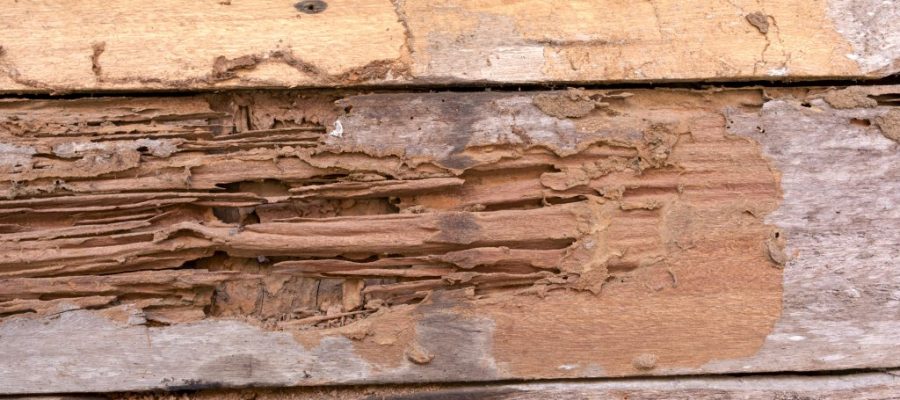What Are the Potential Effects of Termite Damage?
- October 11, 2019
- in Pest Control
- by Ashley Dando
- 83
- 0

Floods, storms, and fire are all on a list of a homeowner’s worst nightmare. But while powerful weather can ruin a building, there are tiny creatures called termites that can create just as much damage.
A termite infestation is a property owner’s worst nightmare. These little bugs form massive colonies that eat away at your home’s physical structures. Termite damage is extensive, expensive, and poses potential health risks.
How extensive is termite damage? Let’s explore.
Subterranean termites are the type homeowners must often discover invading their humble abodes. These insects live in colonies. They feed on dead or decaying plant materials, including wood.
Termites have six legs, an antennae, and wings. They are between a quarter to half an inch in length, although some grow to a full inch.
While they are small insects, a colony of termites is powerful. The group is constantly working, and its members feast around the clock. Subterranean termites can consume more than 6.8 kilograms of wood every week.
Keep in mind termites do not only feast on wood. While wood is their meal of choice, a hungry colony may also eat away at homes made from plaster, metal siding, and insulation.
In nature, a termites job is to break down old and dying trees in forests to make room for new plant life to blossom. Inside a home, however, termites feeding habits can cause physical, financial, and health damages.
A colony of termites in your home can cause widespread structural damage. The pests feed on the internal structures, including beams, posts, and wall studs. In severe cases where termites go undetected for extended periods, the insects create an unsafe and unlivable home.
Subterranean termites live and travel in soil because of the moisture. They enter a home from the ground up, usually through the foundation. A large colony can create cracks in the foundation of a home, causing significant damage.
Formosan termites, a subspecies of subterranean termites, build aboveground nests. They wreak havoc inside walls and in attics where the wood is moist enough to survive.
Areas in your home where moisture is more prominent attract termites first. That’s why most homeowners notice the most physical damage in their bathrooms. Termites will create loose tiles, sagging ceilings, and puncture holes in drywall.
If you have termites, you’ll notice squeaky floors due to weakened materials. Hardwood floors succumb to termites and become weak. Oak boards need to be entirely replaced after a termite infestation.
Termites living within walls feast from the inside out. The walls will become hollow and weaken. This can lead to widespread water damage in your home.
Termites live just below the surface. If you have painted areas in your home with termites living beneath them, the insects’ activity creates bubbles and peeling in the paint.
The physical damages termites create on your home add up. Termites accumulate over $5 billion in property damage (or 7,430,250,000 AUD) every single year.
When dealing with termites, homeowners face two costs. One is for the pest control team who uses professional technology to eliminate the intruders. The second cost is repairing the physical structures damaged by the colony.
Structural repairs include repairing wall studs and support beams, replacing the flooring, fixing water damages in walls, and repainting. Repairing foundation damage is the most expensive repair. A homeowner can expect to spend over $6,000 mending foundational issues.
Don’t let termites eat away at your bank account. Homeowners who stay vigilant can spot a termite colony before it grows into a full-blown infestation.
On top of the structural and financial damages termites cause, there are also health risks to consider. Termites are not a direct threat to people, but their presence in your home can have adverse health effects.
If you come across a termite colony, use caution. Some species can bite and sting. The wounds can be painful, but they are not toxic.
Some people have allergies to the destruction termites create. When a colony moves through your home, it churns up dust and wood particles that spread into the air. This can lead to allergic reactions and asthma attacks.
Many homeowners believe termites are attracted to older homes because they prefer to feast on decaying wood. This is a myth. A hungry colony of termites will feed on anything they can reach, and new homes are just as susceptible to a termite infestation.
To lower your risk of a termite infestation, reduce the amount of wood that has come into contact with soil near your home. Don’t keep firewood and lumber indoors or close to your home. Discard old papers, cardboard, and wilting plants right away.
Keep in mind termites are attracted to damp areas. Reduce the excess moisture in your home by fixing water leaks immediately. Keep your storm drains clean and clear to prevent overly moist soil.
Schedule routine termite inspections with a certified team. These check-ups give homeowners peace of mind by having a professional look for signs of termite colonies. If termites are discovered, the specialists can exterminate them before they cause physical, financial, and health damage.
Termite damage is a scary thought for homeowners. While the insects are small, their large colonies have the power to wreak physical damage, affect your health, and drain your bank account.
If you’re having nightmares of termites destroying your humble home, there’s no need to worry. Safeguard Pest Control has the termite treatment you’re looking for. Contact us today!
Array